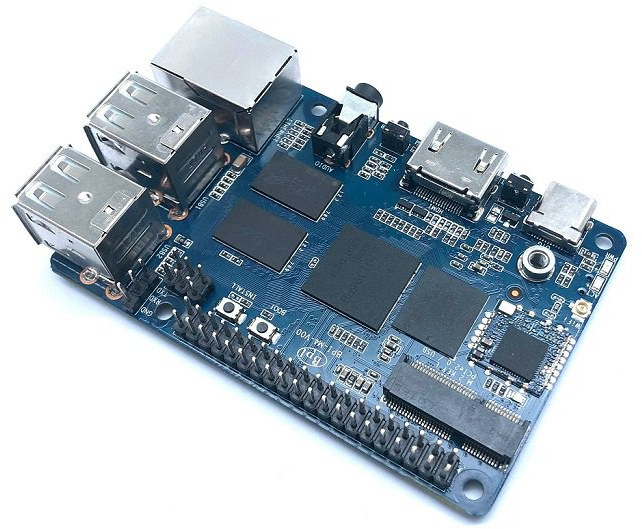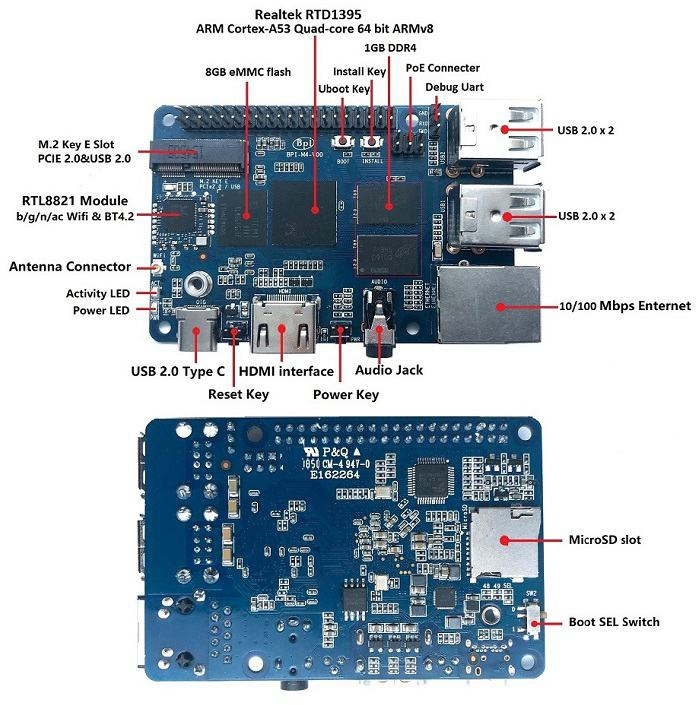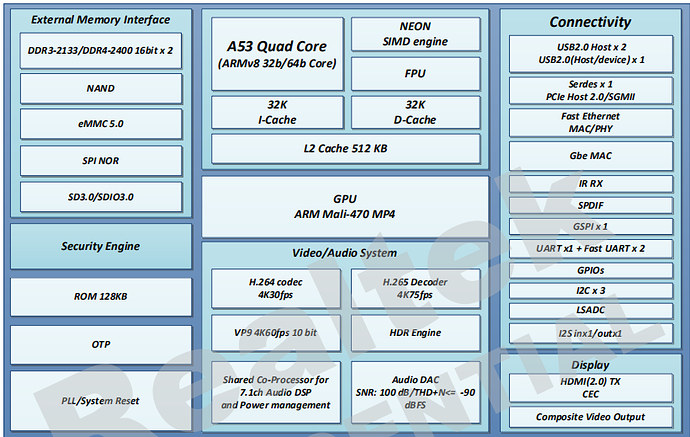Realtek RTD1395 processor is a lower cost version of RTD1295 / RTD1296 processors found in mid-range TV boxes often including HDMI input and output such as Zidoo X9s or LAKE I Home Cloud. The new processor comes with a lower-end Mali-470MP4 GPU and removed some interfaces like HDMI input and native SATA.
So far, we had seen very few hardware platforms built around the processor, but SinoVoIP has just unveiled their latest Banana Pi BPI-M4 board powered by Realtek RTD1395 processor, following Raspberry Pi 3B+ form factor, and adding an M.2 key E socket with PCIe 2.0 and USB 2.0 signals.
 Banana Pi BPI-M4 specifications:
Banana Pi BPI-M4 specifications:
- SoC – Realtek RTD1395 quad-core Arm Cortex-A53 processor with Mali-470 MP4 GPU
- System Memory – 1 GB DDR4 (option 2 GB)
- Storage – 8G eMMC flash (max 64 GB), micro SD slot up to 256GB
- Video Output – 1x HDMI 2.0 port up to 1080p (TBC)
- Audio – Via HDMI port, 3.5mm audio jack
- Connectivity – 100 Mbps Ethernet and 802.11 b/g/n/ac WiFi 5 + Bluetooth 4.2 (via RTL8821 module)
- USB – 4x USB 2.0 host ports, 1x USB 2.0 type C port
- Expansion
- M.2 Key E slot with PCIe 2.0 and USB 2.0
- 40-pin Raspberry Pi compatible GPIO header with UART, I2C, SPI, PWM or power supply
- Misc – Boot selection switch; power and activity LEDs; Power, Reset, Uboot and Install push buttons
- Debugging – 3-pin debug UART header for serial console access
- Power Supply – 5V/2A via USB type-C port or PoE using official Raspberry Pi PoE HAT.
- Dimensions – 92x60mm; Note: Raspberry Pi 3B+ measures 85 x 56 mm, but SinoVoIP appears to have included the connectors for their dimensions
- Weight – 48 grams
 The company now showcases the board with Android 8.1, but a Linux OS is also listed in the specifications without naming the actual distribution used. The Wiki is still very much in process, and only contains some information about the hardware, and only placeholders for the software part.
The company now showcases the board with Android 8.1, but a Linux OS is also listed in the specifications without naming the actual distribution used. The Wiki is still very much in process, and only contains some information about the hardware, and only placeholders for the software part.
Some of you may wonder why SinoVoIP decided to only include Fast Ethernet. The answer can be found in the RTD1395 block diagram below: The chip includes an IP block with a Fast Ethernet PHY and MAC, and an IP block with a Gigabit Ethernet MAC, so they save one Ethernet transceiver chip by going the Fast Ethernet route.
Another oddity in the board’s specifications is the HDMI port support for up to 1080p only. That one may be a mistake because RTD1395 processor comes with an HDMI 2.0 transmitter capable of 4K @ 60 Hz output, as well as a 4K H.264 / 30fps, H.265 / 75 fps, and VP9 / 60 fps video processing unit.
It’s unclear when the board will become available, but the company informed me Banana Pi BPI-M4 pricing will be known by next week.

Jean-Luc started CNX Software in 2010 as a part-time endeavor, before quitting his job as a software engineering manager, and starting to write daily news, and reviews full time later in 2011.
Support CNX Software! Donate via cryptocurrencies, become a Patron on Patreon, or purchase goods on Amazon or Aliexpress





